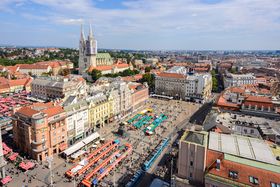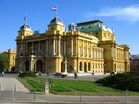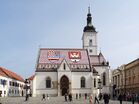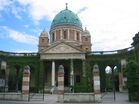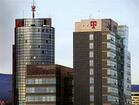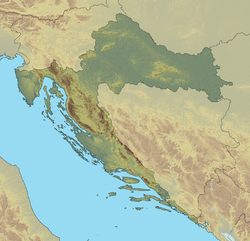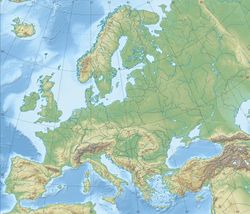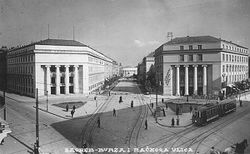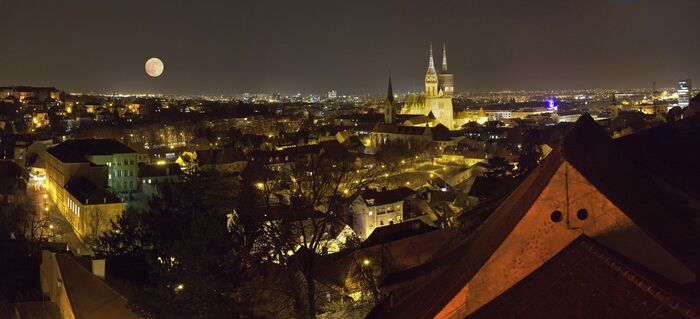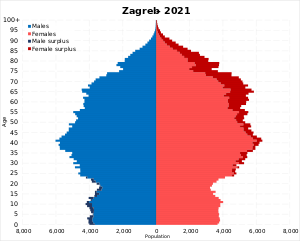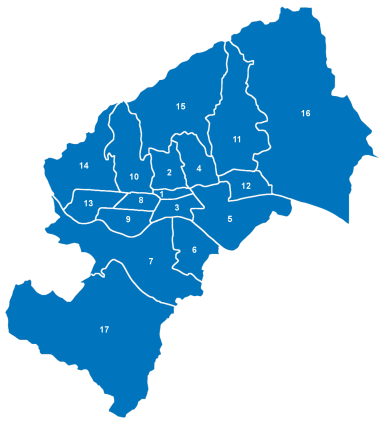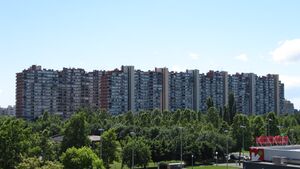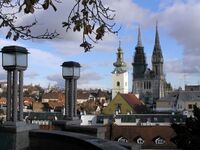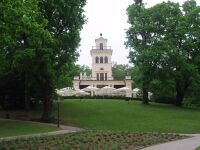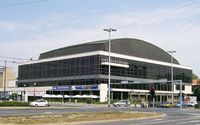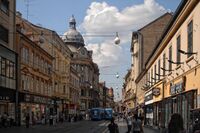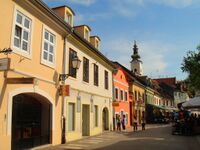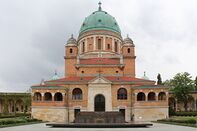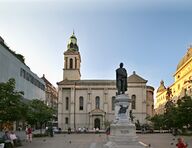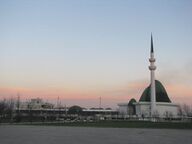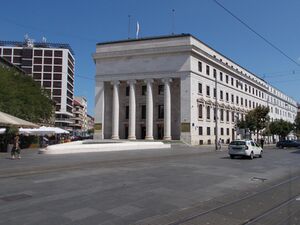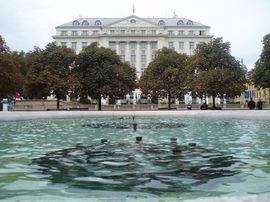زغرب
Zagreb | |
|---|---|
| Grad Zagreb City of Zagreb | |
|
Clockwise, from top: Ban Jelačić Square, St. Mark's Square, Cibona & HOTO towers, Art Pavilion, Church Of Christ The King, Mirogoj and Croatian National Theatre | |
 | |
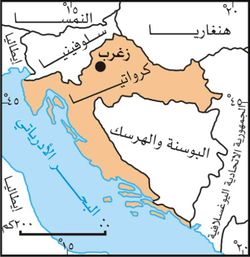 موقع زغرب في كرواتيا | |
| الإحداثيات: 45°49′0″N 15°59′0″E / 45.81667°N 15.98333°E | |
| البلد | كرواتيا |
| المقاطعة | زغرب |
| ابراشية روم كاثوليك | 1094 |
| مدينة ملكية حرة | 1242 |
| توحدت | 1850 |
| الحكومة | |
| • رئيس البلدية | ميلان بانديچ (SDP) |
| المساحة | |
| • Capital city | 641٫29 كم² (247٫60 ميل²) |
| التعداد (2007 estimate)[2] | |
| • Capital city | 784٬900 |
| • الكثافة | 1٬223٫9/km2 (3٬170/sq mi) |
| • العمرانية | 1٬093٬900 |
| • تعداد 2001 | 779٬145 |
| منطقة التوقيت | UTC+1 (CET) |
| • الصيف (التوقيت الصيفي) | UTC+2 (CEST) |
| Postal code | 10000 |
| مفتاح الهاتف | 01 |
| Licence plate | ZG |
| أدنى نقطة | 122 m |
| أعلى نقطة | 1,035 m (سلييمه) |
| الموقع الإلكتروني | zagreb.hr |
زغرب (Zagreb ؛ /ˈzɑːɡrɛb,_ˈzæɡrɛb,_zɑːˈɡrɛb/ ZAH-greb, ZAG-reb, zah-GREB,[3] كرواتية: [zǎːɡreb] (![]() استمع)[أ])[5] هي عاصمة كرواتيا وأكبر مدنها.[6] قدر عدد سكانها عام 2001 northwest of the country, along the Sava river, at the southern slopes of the Medvednica mountain. Zagreb stands near the international border between Croatia and Slovenia at an elevation of approximately 122 m (400 ft) above sea level.[7] The population of the Zagreb urban agglomeration is 1,071,150,[8] approximately a quarter of the total population of Croatia, while at the 2021 census the city itself had a population of 767,131.[9]
استمع)[أ])[5] هي عاصمة كرواتيا وأكبر مدنها.[6] قدر عدد سكانها عام 2001 northwest of the country, along the Sava river, at the southern slopes of the Medvednica mountain. Zagreb stands near the international border between Croatia and Slovenia at an elevation of approximately 122 m (400 ft) above sea level.[7] The population of the Zagreb urban agglomeration is 1,071,150,[8] approximately a quarter of the total population of Croatia, while at the 2021 census the city itself had a population of 767,131.[9]
Zagreb is a city with a rich history dating from Roman times. The oldest settlement in the vicinity of the city was the Roman Andautonia, in today's Ščitarjevo.[10] The historical record of the name "Zagreb" dates from 1134, in reference to the foundation of the settlement at Kaptol in 1094. Zagreb became a free royal city in 1242.[11] In 1851 Janko Kamauf became Zagreb's first mayor.[12]
Zagreb has special status as a Croatian administrative division - it comprises a consolidated city-county (but separate from Zagreb County),[13] and is administratively subdivided into 17 city districts.[14] Most of the city districts lie at a low elevation along the valley of the river Sava, but northern and northeastern city districts, such as Podsljeme[15] and Sesvete[16] districts are situated in the foothills of the Medvednica mountain,[17] making the city's geographical image quite diverse. The city extends over 30 km (19 mi) east-west and around 20 km (12 mi) north-south.[18][19]
Zagreb ranks as a global city, with a Beta − rating from the Globalization and World Cities Research Network.[20]
The transport connections, the concentration of industry, scientific, and research institutions and industrial tradition underlie its leading economic position in Croatia.[21][22][23] Zagreb is the seat of the central government, administrative bodies, and almost all government ministries.[24][25][26] Almost all of the largest Croatian companies, media, and scientific institutions have their headquarters in the city. Zagreb is the most important transport hub in Croatia: here Central Europe, the Mediterranean and Southeast Europe meet, making the Zagreb area the centre of the road, rail and air networks of Croatia. It is a city known for its diverse economy, high quality of living, museums, sporting, and entertainment events. Major branches of Zagreb's economy include high-tech industries and the service sector.
الاسم
The etymology of the name Zagreb is unclear. It was used for the united city only from 1852, but it had been in use as the name of the Zagreb Diocese since the 12th century and was increasingly used for the city in the 17th century.[27] The name is first recorded in a charter by archbishop of Esztergom Felician, dated 1134, mentioned as Zagrabiensem episcopatum.[28]
The older form of the name is Zagrab. The modern Croatian form Zagreb is first recorded in a 1689 map by Nicolas Sanson. An even older form is reflected in Hungarian Zabrag (recorded from c. 1200 and in use until the 18th century). For this, Hungarian linguist Gyula Décsy proposes the etymology of Chabrag, a well-attested hypocorism of the name Cyprian. The same form is reflected in a number of Hungarian toponyms, such as Csepreg.[29]
The name might be derived from Proto-Slavic word *grębъ which means hill, uplift. (However, note Croatian brȇg < Proto-Slavic *bergъ, which also means '(smaller) hill', and za brȇg 'to or toward the hill' for the seemingly metathesized variant in Hungarian, Zabrag – possibly modified from assumed *Zabreg because of Hungarian vowel harmony.) An Old Croatian reconstructed name *Zagrębъ is manifested through the German name of the city Agram.[30]
The name Agram was used in German in the Habsburg period; this name has been classified as "probably of Roman origin"[31] but according to Décsy (1990) it could be an Austrian German reanalysis of *Zugram. [29] In Middle Latin and Modern Latin, Zagreb is known as Agranum (the name of an unrelated Arabian city in Strabo), Zagrabia or Mons Graecensis (also Mons Crecensis, in reference to Grič (Gradec)).
In Croatian folk etymology, the name of the city has been derived from either the verb za-grab-, meaning "to scoop" or "to dig". One folk legend illustrating this derivation ties the name to a drought of the early 14th century, during which Augustin Kažotić (c. 1260–1323) is said to have dug a well which miraculously produced water.[32] In another legend,[33][34][35][36][37] a city governor is thirsty and orders a girl named Manda to "scoop" water from the Manduševac well (nowadays a fountain in Ban Jelačić Square), using the imperative: Zagrabi, Mando! ("Scoop, Manda!").[38]
التاريخ
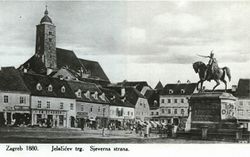
ورد اسم زغرب أول مرة في وثيقة تعود إلى عام 1094م في زمن الملك لاديسلاس الأول Ladislas ملك المجر وكرواتيا، حين أصبحت مقراً لأسقفية تابعة للكنيسة الكاثوليكية بروما. في تلك الفترة كانت المناطق المأهولة تقتصر على منطقتين هما گرادك Gradec وكاپتول Kaptol، وقد أصبحت زغرب عاصمة في عام 1557. وفي عام 1669 أسس اليسوعيون في زغرب أول أكاديمية، وتم تأسيس جامعة زغرب، وفي عام 1776 انتقل مركز الحكومة من ڤارازدين Varazdin إلى زغرب.
وفى القرن التاسع عشر، أصبحت زغرب مركزاً سياسياً وعلمياً وأدبياً مهماً في كرواتيا وفي عام 1918، أصبحت كرواتيا جزءاً من المملكة الجديدة التى كانت تضم سكاناً من الصرب والكروات والسلوفين، والتي أطلق عليها اسم يوغوسلافيا فيما بعد.
وفي عام 1946 أصبحت زغرب عاصمة لكرواتيا الحديثة في الاتحاد اليوغسلافي تحت زعامة تيتو، وفي عام 1981 مات تيتو رئيس الاتحاد اليوغسلافي، وبموته اشتعلت جذوة النضال من أجل الانفصال القومي. في عام 1991 أعلن البرلمان الكرواتي استقلال كرواتيا رسمياً عن الاتحاد اليوغسلافي، ودخلت المنطقة في الحرب الأهلية بين السلاف والكروات (فيما يسمى حرب البلقان). وبعد انتهاء حرب البلقان في العام 1995 وتقسيم الاتحاد اليوغسلافي، صارت زغرب العاصمة السياسية والإدارية لجمهورية كرواتيا.
الجغرافيا
تقع على المنحدرات الجنوبية لجبل ميدفيدنيشا وعلى الضفة الشمالية لنهر ساڤا. متوسط ارتفاعها عن سطح البحر هو 120 م تقريبا. موقعها متميز فهي تصل أوروبا الوسطى بالبحر الأدرياتيكي.
الموقع الاستراتيجي والمؤسسات التعليمية، مراكز الأبحاث العلمية, الصناعات التقليدية والمتقدمة هي أهم عوامل كون زغرب ذات مكانة اقتصادية هامة. زغرب هي المقر الرئيس لجميع المرافق الحكومية ومعظم الوزارات.
المناخ
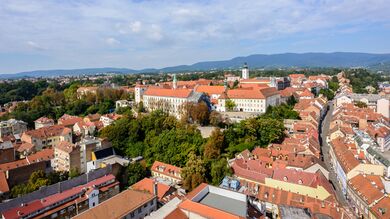
The climate of Zagreb is classified as an oceanic climate (Köppen climate classification Cfb) with significant continental influences, very closely bordering on a humid continental climate (Dfa/Dfb) as well as a humid subtropical climate (Cfa). Zagreb has four separate seasons. Summers are generally warm, sometimes hot. In late May it gets significantly warmer, temperatures start rising and it often becomes very warm or even hot with occasional afternoon and evening thunderstorms. Heatwaves can occur but are short-lived. Temperatures rise above 30 °C (86 °F) on average 14.6 days each summer. During summertime, rainfall is abundant and it mainly falls during thunderstorms. With 840 mm of precipitation per year, Zagreb is Europe's ninth wettest capital, receiving less precipitation than Luxembourg but more than Brussels, Paris or London. Compared to these cities, however, Zagreb has less rainy days, but the annual rainfall is higher due to heavier showers occurring mainly in late spring and summer. Autumn in its early stage often brings pleasant and sunny weather with occasional episodes of rain later in the season. Late autumn is characterized by a mild increase in the number of rainy days and a gradual decrease in daily temperature averages. Morning fog is common from mid-October to January, with northern city districts at the foothills of the Medvednica mountain as well as south-central districts along the Sava river being more prone to longer fog accumulation. Winters are relatively cold, bringing overcast skies and a precipitation decrease pattern. February is the driest month, averaging 39 mm of precipitation. On average there are 29 days with snowfall, with the first snow usually falling in early December. However, in recent years, the number of days with snowfall in wintertime has decreased considerably. As the season progresses, sunny days become more frequent, bringing higher temperatures. However, sometimes cold spells can occur, mostly in the early stages of spring. Sometimes cold spells can occur as well, mostly in the season's early stages. The average daily mean temperature in the winter is around 1 °C (34 °F) (from December to February) and the average temperature in the summer is 22.0 °C (71.6 °F).[39]
The highest recorded temperature at the Maksimir weather station was 40.4 °C (104.7 °F) in July 1950, and lowest was −27.3 °C (−17.1 °F) in February 1956.[40] A temperature of −30.5 °C (−22.9 °F) was recorded on the since defunct Borongaj Airfield in February 1940.[41]
| Climate data for Zagreb Maksimir (1971–2000, extremes 1949–2019) | |||||||||||||
|---|---|---|---|---|---|---|---|---|---|---|---|---|---|
| Month | Jan | Feb | Mar | Apr | May | Jun | Jul | Aug | Sep | Oct | Nov | Dec | Year |
| Record high °C (°F) | 19.4 (66.9) |
22.6 (72.7) |
26.0 (78.8) |
30.5 (86.9) |
33.7 (92.7) |
37.6 (99.7) |
40.4 (104.7) |
39.8 (103.6) |
34.0 (93.2) |
28.3 (82.9) |
25.4 (77.7) |
22.5 (72.5) |
40.4 (104.7) |
| Mean daily maximum °C (°F) | 3.7 (38.7) |
6.8 (44.2) |
11.9 (53.4) |
16.3 (61.3) |
21.5 (70.7) |
24.5 (76.1) |
26.7 (80.1) |
26.3 (79.3) |
22.1 (71.8) |
15.8 (60.4) |
8.9 (48.0) |
4.6 (40.3) |
15.8 (60.4) |
| Daily mean °C (°F) | 0.3 (32.5) |
2.3 (36.1) |
6.4 (43.5) |
10.7 (51.3) |
15.8 (60.4) |
18.8 (65.8) |
20.6 (69.1) |
20.1 (68.2) |
15.9 (60.6) |
10.5 (50.9) |
5.0 (41.0) |
1.4 (34.5) |
10.7 (51.3) |
| Mean daily minimum °C (°F) | −3.0 (26.6) |
−1.8 (28.8) |
1.6 (34.9) |
5.2 (41.4) |
9.8 (49.6) |
13.0 (55.4) |
14.7 (58.5) |
14.4 (57.9) |
10.8 (51.4) |
6.2 (43.2) |
1.4 (34.5) |
−1.7 (28.9) |
5.9 (42.6) |
| Record low °C (°F) | −24.3 (−11.7) |
−27.3 (−17.1) |
−18.3 (−0.9) |
−4.4 (24.1) |
−1.8 (28.8) |
2.5 (36.5) |
5.4 (41.7) |
3.7 (38.7) |
−0.6 (30.9) |
−5.6 (21.9) |
−13.5 (7.7) |
−19.8 (−3.6) |
−27.5 (−17.5) |
| Average precipitation mm (inches) | 43.2 (1.70) |
38.9 (1.53) |
52.6 (2.07) |
59.3 (2.33) |
72.6 (2.86) |
95.3 (3.75) |
77.4 (3.05) |
92.3 (3.63) |
85.8 (3.38) |
82.9 (3.26) |
80.1 (3.15) |
59.6 (2.35) |
840.1 (33.07) |
| Average precipitation days (≥ 0.1 mm) | 9.8 | 9.4 | 11.0 | 13.0 | 13.5 | 13.7 | 11.2 | 10.4 | 10.4 | 10.9 | 11.3 | 11.0 | 135.6 |
| Average snowy days (≥ 1.0 cm) | 10.3 | 7.1 | 1.8 | 0.2 | 0.0 | 0.0 | 0.0 | 0.0 | 0.0 | 0.0 | 2.9 | 6.7 | 29.0 |
| Average relative humidity (%) | 82.5 | 76.4 | 70.3 | 67.5 | 68.3 | 69.7 | 69.1 | 72.1 | 77.7 | 81.3 | 83.6 | 84.8 | 75.3 |
| Mean monthly sunshine hours | 55.8 | 98.9 | 142.6 | 168.0 | 229.4 | 234.0 | 275.9 | 257.3 | 189.0 | 124.0 | 63.0 | 49.6 | 1٬887٫5 |
| Percent possible sunshine | 23 | 39 | 43 | 45 | 54 | 55 | 63 | 63 | 54 | 41 | 26 | 23 | 47 |
| Average ultraviolet index | 1 | 2 | 3 | 5 | 7 | 8 | 8 | 7 | 5 | 3 | 1 | 1 | 4 |
| Source: Croatian Meteorological and Hydrological Service[39][40] and Weather Atlas[42] | |||||||||||||
| Climate data for Zagreb | |||||||||||||
|---|---|---|---|---|---|---|---|---|---|---|---|---|---|
| Month | Jan | Feb | Mar | Apr | May | Jun | Jul | Aug | Sep | Oct | Nov | Dec | Year |
| Mean daily daylight hours | 9.0 | 10.0 | 12.0 | 14.0 | 15.0 | 16.0 | 15.0 | 14.0 | 13.0 | 11.0 | 9.0 | 9.0 | 12.3 |
| Source: Weather Atlas[42] | |||||||||||||
أفق المدينة
The most important historical high-rise constructions are Neboder (1958) on Ban Jelačić Square, Cibona Tower (1987), and Zagrepčanka (1976) on Savska Street, Mamutica in Travno (Novi Zagreb – istok district, built in 1974) and Zagreb TV Tower on Sljeme (built in 1973).[43]
In the 2000s, the City Assembly approved a new plan that allowed for the many recent high-rise buildings in Zagreb, such as the Almeria Tower, Eurotower, HOTO Tower, Zagrebtower and one of the tallest skyscrapers Sky Office Tower.[44][45]
In Novi Zagreb, the neighbourhoods of Blato and Lanište expanded significantly, including the Zagreb Arena and the adjoining business centre.[46]
Due to a long-standing restriction that forbade the construction of 10-story or higher buildings, most of Zagreb's high-rise buildings date from the 1970s and 1980s and new apartment buildings on the outskirts of the city are usually 4–8 floors tall. Exceptions to the restriction have been made in recent years, such as permitting the construction of high-rise buildings in Lanište or Kajzerica.[47]
محيط زغرب
The wider Zagreb area has been continuously inhabited since the prehistoric period, as witnessed by archaeological findings in the Veternica cave from the Paleolithic and excavation of the remains of the Roman Andautonia near the present village of Šćitarjevo.
Picturesque former villages on the slopes of Medvednica, Šestine, Gračani, and Remete, maintain their rich traditions, including folk costumes, Šestine umbrellas, and gingerbread products.
To the north is the Medvednica Mountain (كرواتية: Zagrebačka gora), with its highest peak Sljeme(1,035 m), where one of the tallest structures in Croatia, Zagreb TV Tower is located. The Sava and the Kupa valleys are to the south of Zagreb, and the region of Hrvatsko Zagorje is located on the other (northern) side of the Medvednica hill. In mid-January 2005, Sljeme held its first World Ski Championship tournament.
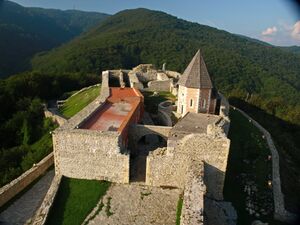
From the summit, weather permitting, the vista reaches as far as Velebit Range along Croatia's rocky northern coast, as well as the snow-capped peaks of the towering Julian Alps in neighboring Slovenia. There are several lodging villages, offering accommodation and restaurants for hikers. Skiers visit Sljeme, which has four ski-runs, three ski-lifts, and a chairlift.
The old Medvedgrad, a recently restored medieval burg was built in the 13th century on Medvednica hill. It overlooks the western part of the city and also hosts the Shrine of the Homeland, a memorial with an eternal flame, where Croatia pays reverence to all its heroes fallen for homeland in its history, customarily on national holidays. The ruined medieval fortress Susedgrad is located on the far-western side of Medvednica hill. It has been abandoned since the early 17th century, but it is visited during the year.
Zagreb occasionally experiences earthquakes, due to the proximity of Žumberak-Medvednica fault zone.[48] It's classified as an area of high seismic activity.[49] The area around Medvednica was the epicentre of the 1880 Zagreb earthquake (magnitude 6.3), and the area is known for occasional landslide threatening houses in the area.[50] The proximity of strong seismic sources presents a real danger of strong earthquakes.[50] Croatian Chief of Office of Emergency Management Pavle Kalinić stated Zagreb experiences around 400 earthquakes a year, most of them being imperceptible. However, in case of a strong earthquake, it's expected that 3,000 people would die and up to 15,000 would be wounded.[51]
السكان
Zagreb is by far the largest city in Croatia in terms of area and population. The 2021 census counted 767,131 residents.[9]
Zagreb metropolitan area population is slightly above 1.0 million inhabitants,[52] as it includes the Zagreb County.[53] Zagreb metropolitan area makes approximately a quarter of a total population of Croatia. In 1997, the City of Zagreb itself was given special County status, separating it from Zagreb County,[54] although it remains the administrative centre of both.
The majority of its citizens are Croats making up 93% of the city's population (2011 census). The same census records around 55,000 residents belonging to ethnic minorities: 17,526 Serbs (2.22%), 8,119 Bosniaks (1.03%), 4,292 Albanians (0.54%), 2,755 Romani (0.35%), 2,132 Slovenes (0.27%), 1,194 Macedonians (0.15%), 1,191 Montenegrins (0.15%), and a number of other smaller communities.[55]
After the easing of Covid-19 pandemic restrictions, thousands of foreign workers immigrated to Zagreb due to the shortage of labor force in Croatia. These workers primarily come from countries such as Nepal, the Philippines, India, and Bangladesh, as well as some European countries including Kosovo, Bosnia and Herzegovina, and North Macedonia.[56]
| population | 48266 | 54761 | 67188 | 82848 | 111565 | 136351 | 167765 | 258024 | 356529 | 393919 | 478076 | 629896 | 723065 | 777826 | 779145 | 790017 | 767131 |
| 1857 | 1869 | 1880 | 1890 | 1900 | 1910 | 1921 | 1931 | 1948 | 1953 | 1961 | 1971 | 1981 | 1991 | 2001 | 2011 | 2021 |
أحياء المدينة
Since 14 December 1999 City of Zagreb is divided into 17 city districts (gradska četvrt, pl. gradske četvrti):
| # | District | Area (km2) | Population (2001)[57] |
Population (2011)[58] |
Population density (2011) |
|---|---|---|---|---|---|
| 1. | Donji Grad | 3.01 | 45,108 | 37,024 | 12,333 |
| 2. | Gornji Grad–Medveščak | 10.12 | 36,384 | 30,962 | 3,091 |
| 3. | Trnje | 7.37 | 45,267 | 42,282 | 5,716 |
| 4. | Maksimir | 14.35 | 49,750 | 48,902 | 3,446 |
| 5. | Peščenica – Žitnjak | 35.30 | 58,283 | 56,487 | 1,599 |
| 6. | Novi Zagreb – istok | 16.54 | 65,301 | 59,055 | 3,581 |
| 7. | Novi Zagreb – zapad | 62.59 | 48,981 | 58,103 | 927 |
| 8. | Trešnjevka – sjever | 5.83 | 55,358 | 55,425 | 9,493 |
| 9. | Trešnjevka – jug | 9.84 | 67,162 | 66,674 | 6,768 |
| 10. | Črnomerec | 24.33 | 38,762 | 38,546 | 1,605 |
| 11. | Gornja Dubrava | 40.28 | 61,388 | 61,841 | 1,545 |
| 12. | Donja Dubrava | 10.82 | 35,944 | 36,363 | 3,370 |
| 13. | Stenjevec | 12.18 | 41,257 | 51,390 | 4,257 |
| 14. | Podsused – Vrapče | 36.05 | 42,360 | 45,759 | 1,270 |
| 15. | Podsljeme | 60.11 | 17,744 | 19,165 | 320 |
| 16. | Sesvete | 165.26 | 59,212 | 70,009 | 427 |
| 17. | Brezovica | 127.45 | 10,884 | 12,030 | 94 |
| TOTAL | 641.43 | 779,145 | 790,017 | 1,236 |
City districts are subdivided in 218 local committees as primary units of local self-government.[59]
المستوطنات
The city itself is not the only standalone settlement in the City of Zagreb administrative area – there are a number of larger urban settlements like Sesvete and Lučko and a number of smaller villages attached to it whose population is tracked separately.[60]
There are 70 settlements in the City of Zagreb administrative area:
|
|
|
Politics and government
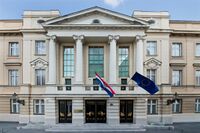
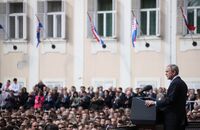
Zagreb is the capital of the Republic of Croatia, its political center and the center of various state institutions. On the St. Mark's Square are the seats of the Government of the Republic of Croatia in the Banski Dvori complex, the Croatian Parliament (Sabor), as well as the Constitutional Court of the Republic of Croatia. Various ministries and state agencies are located in the wider area of the City of Zagreb.
City governance
The current mayor of Zagreb is Tomislav Tomašević ('We can!'), elected in the 2021 Zagreb local elections, the second round of which was held on 30 May 2021. There are two deputy mayors elected from the same list, Danijela Dolenec and Luka Korlaet.
The Zagreb Assembly is composed of 51 representatives, elected in the 2021 Zagreb local elections.
The Zagreb Assembly is composed of 51 representatives, elected in the 2021 Zagreb local elections.
According to the Constitution, the city of Zagreb, as the capital of Croatia, has a special status. As such, Zagreb performs self-governing public affairs of both city and county. It is also the seat of the Zagreb County which encircles Zagreb.
The city administration bodies are the Zagreb City Assembly (Gradska skupština Grada Zagreba) as the representative body and the mayor of Zagreb (Gradonačelnik Grada Zagreba) who is the executive head of the city.
The City Assembly is the representative body of the citizens of the City of Zagreb elected for a four-year term on the basis of universal suffrage in direct elections by secret ballot using proportional system with d'Hondt method in a manner specified by law. There are 51 representatives in the City Assembly, among them the president and vice-presidents of the assembly are elected by the representatives.

Before 2009, the mayor was elected by the City Assembly. It was changed to direct elections by majoritarian vote (two-round system) in 2009. The mayor is the head of the city administration and has two deputies (directly elected together with him/her).
The term of office of the mayor (and his/her deputies) is four years. The mayor (with the deputies) may be recalled by a referendum according to the law (not less than 20% of all electors in the City of Zagreb or not less than two-thirds of the Zagreb Assembly city deputies have the right to initiate a city referendum regarding recalling of the mayor; when a majority of voters taking part in the referendum vote in favor of the recall, provided that majority includes not less than one-third of all persons entitled to vote in the City of Zagreb, i.e. 1⁄3 of persons in the City of Zagreb electoral register, the mayor's mandate shall be deemed revoked and special mayoral by-elections shall be held).
In the City of Zagreb, the mayor is also responsible for the state administration (due to the special status of Zagreb as a "city with county rights", there isn't a State Administration Office which in all counties performs tasks of the central government).
City administration offices, institutions and services (18 city offices, 1 public institute or bureau and 2 city services) have been founded for performing activities within the self-administrative sphere and activities entrusted by the state administration. The city administrative bodies are managed by the principals (appointed by the mayor for a four-year term of office, may be appointed again to the same duty). The City Assembly Professional Service is managed by the secretary of the City Assembly (appointed by the Assembly).
Local government is organised in 17 city districts represented by City District Councils. Residents of districts elect members of councils.[61]
العلاقات الدولية
Twin towns – sister cities
Zagreb is twinned with the following towns and cities:[62][63][64]
 Bologna, Italy (since 1963)
Bologna, Italy (since 1963) Mainz, Germany (since 1967)
Mainz, Germany (since 1967) Saint Petersburg, Russia (since 1968)[65]
Saint Petersburg, Russia (since 1968)[65] Tromsø, Norway (since 1971)
Tromsø, Norway (since 1971) Buenos Aires, Argentina (since 1972)
Buenos Aires, Argentina (since 1972) Kyoto, Japan (since 1972)[66]
Kyoto, Japan (since 1972)[66] Lisbon, Portugal (since 1977)[67][68]
Lisbon, Portugal (since 1977)[67][68] Pittsburgh, United States (since 1980)
Pittsburgh, United States (since 1980) Shanghai, China (since 1980)
Shanghai, China (since 1980) Budapest, Hungary (since 1994)[69]
Budapest, Hungary (since 1994)[69] La Paz, Bolivia (since 2000)
La Paz, Bolivia (since 2000) Sarajevo, Bosnia and Herzegovina (since 2001)[70]
Sarajevo, Bosnia and Herzegovina (since 2001)[70] Ljubljana, Slovenia (since 2001)[71]
Ljubljana, Slovenia (since 2001)[71] Podgorica, Montenegro (since 2006)
Podgorica, Montenegro (since 2006) Tabriz, Iran (since 2006)[72]
Tabriz, Iran (since 2006)[72] Ankara, Turkey (since 2008)[73]
Ankara, Turkey (since 2008)[73] London, United Kingdom (since 2009)
London, United Kingdom (since 2009) Skopje, North Macedonia (since 2011)
Skopje, North Macedonia (since 2011) Warsaw, Poland (since 2011)[74]
Warsaw, Poland (since 2011)[74] Pristina, Kosovo[ب] (since 2012)
Pristina, Kosovo[ب] (since 2012) Astana, Kazakhstan (since 2014)[75]
Astana, Kazakhstan (since 2014)[75] Rome, Italy (since 2014)[64]
Rome, Italy (since 2014)[64] Vienna, Austria (since 2014)[64]
Vienna, Austria (since 2014)[64] Petrinja, Croatia (since 2015)[76]
Petrinja, Croatia (since 2015)[76] Vukovar, Croatia (since 2016)[77]
Vukovar, Croatia (since 2016)[77] Xiangyang, China (since 2017)[78]
Xiangyang, China (since 2017)[78]
المدن الشريكة
The city has partnership arrangements with:
السكان
زغرب هي أكبر مدن البلاد والمدينة الوحيدة (بضواحيها) التي يفوق عدد سكانها المليون نسمة في كرواتيا. حوالي 1,088,000 نسمة يقطنون زغرب بضواحيها التي تضم بعض المدن الصغيرة مثل ساموبر وفيلكا جوريشا.
غالبية السكان هم كروات بنسبة 91.94% (تعداد 2001). نفس الإحصائية تذكر أن حوالي 40 ألف شخص من سكان العاصمة ينتمون لعرقيات أخرى. الأقليات العرقية الأخرى هي على النحو التالي:
- الصرب، 18,800 نسمة (2.41%).
- البوسنيون، 6,200 نسمة (0.80%).
- الألبان، 3,400 نسمة (0.43%).
- السلوفينيون، 3,225 نسمة (0.41%).
- بعض الغجر والمقدونيين والأقليات الأخرى ويشكلون بقية السكان.
التعليم والثقافة
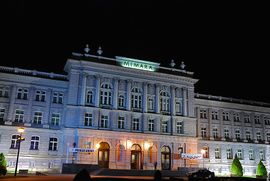
تُعد جامعة زغرب واحدة من أهم وأقدم جامعات أوربا، تخرج منها حتى الآن اكثر من مائتي ألف طالب، ومنحت اكثر من 18ألف شهادة ماجستير وثمانية آلاف شهادة دكتوراه، تضم 28 كلية علمية وتعليمية وثلاث أكاديميات و22 معهداً في مجال العلوم الاجتماعية والطبيعية، و38معهداً ثقافياً و10متاحف وطنية، أهمها متحف زغرب الوطني ومتحف الفنون والرسم ومتحف الفن الحديث وتضم زغرب 14مركزاً ثقافياً و7 مسارح وطنية، وتملك العديد من المشافي والمراكز الطبية الحديثة.
تشتهر مدينة زغرب بالأبنية القوطية الجميلة التي تعود إلى عصر الباروك، وعلى رأسها الكاتدرائيات (كاتدرائية ماركوس وكاتدرائية كاترينا)، وهناك القصور القوطية المشهورة.
Souvenirs and gastronomy
Numerous shops, boutiques, store houses and shopping centers offer a variety of quality clothing. There are about fourteen big shopping centers in Zagreb. Zagreb's offerings include crystal, china and ceramics, wicker or straw baskets, and top-quality Croatian wines and gastronomic products.
Notable Zagreb souvenirs are the tie or cravat, an accessory named after Croats who wore characteristic scarves around their necks in the Thirty Years' War in the 17th century and the ball-point pen, a tool developed from the inventions by Slavoljub Eduard Penkala, an inventor and a citizen of Zagreb.
Many Zagreb restaurants offer various specialties of national and international cuisine. Domestic products which deserve to be tasted include turkey, duck or goose with mlinci (a kind of pasta), štrukli (cottage cheese strudel), sir i vrhnje (cottage cheese with cream), kremšnite (custard slices in flaky pastry), and orehnjača (traditional walnut roll).
المنظمات الدينية
المناطق المحيطة بها
تطورت زغرب حالياً خارج المركز القديم، الذي كان يضم الكابتول والكراديك، وتزايد عدد سكانها، وخاصة بعد حرب البلقان بسبب الهجرة وتدمير الكثير من القرى، واتسعت المدينة اتساعاً كبيراً، بشوراعها العريضة وساحاتها الجميلة. وتعد عقدة مواصلات تربط شرقي أوربا وغربها وبحر الادرياتيك، كما ترتبط مع العديد من العواصم الأوربية بخطوط جوية عديدة، تنطلق من مطار لوكو Lucko الذي يقع على بعد 16كم شمال غربي مدينة زغرب.
مدينة زغرب تحيط بها الغابات الخضراء وتتوسطها الحدائق الجميلة ويؤمها السياح من أنحاء أوربا كافة.
Religion
The Archdiocese of Zagreb is a metropolitan see of the Catholic Church in Croatia, serving as its religious center. The Archbishop is Josip Cardinal Bozanić. The Catholic Church is the largest religious organisation in Zagreb, Catholicism being the predominant religion of Croatia, with over 1.1 million adherents.[83] Zagreb is also the Episcopal see of the Metropolitanate of Zagreb and Ljubljana of the Serbian Orthodox Church. Islamic religious organization of Croatia has the see in Zagreb. President is Mufti Aziz Hasanović. There used to be a mosque in the Meštrović Pavilion during World War II[84] at the Square of the Victims of Fascism, but it was relocated to the neighborhood of Borovje in Peščenica. Mainstream Protestant churches have also been present in Zagreb – Evangelical (Lutheran) Church and Reformed Christian (Calvinist) Church. The Church of Jesus Christ of Latter-day Saints (LDS Church) is also present in the Zagreb neighborhood of Jarun whereas Jehovah's Witnesses have their headquarters in Central Zagreb.[85] In total there are around 40 non-Catholic religious organizations and denominations in Zagreb with their headquarters and places of worship across the city making it a large and diverse multicultural community. There is also significant Jewish history through the Holocaust.
Economy
أجزاء من هذا المقال (أولئك المتعلقين بـ القِسم) تحتاج أن تـُحدَّث. (December 2020) |
Important branches of industry are: production of electrical machines and devices, chemical, pharmaceutical, textile, food and drink processing. Zagreb is an international trade and business centre, as well as an essential transport hub placed at the crossroads of Central Europe, the Mediterranean and the Southeast Europe.[86] Almost all of the largest Croatian as well as Central European companies and conglomerates such as Agrokor, INA, Hrvatski Telekom have their headquarters in the city.
The only Croatian stock exchange is the Zagreb Stock Exchange (كرواتية: Zagrebačka burza), which is located in Eurotower, one of the tallest Croatian skyscrapers.
According to 2008 data, the city of Zagreb has the highest PPP and nominal gross domestic product per capita in Croatia at $32,185 and $27,271 respectively, compared to the Croatian averages of US$18,686 and $15,758.[87]
As of May 2015, the average monthly net salary in Zagreb was 6,669 kuna, about €870 (Croatian average is 5,679 kuna, about €740).[88][89] At the end of 2012, the average unemployment rate in Zagreb was around 9.5%.[90] 34% of companies in Croatia have headquarters in Zagreb, and 38.4% of the Croatian workforce works in Zagreb, including almost all banks, utility and public transport companies.[91][92][93]
Companies in Zagreb create 52% of the total turnover and 60% of the total profit of Croatia in 2006 as well as 35% of Croatian export and 57% of Croatian import.[94][95]
The following table includes some of the main economic indicators for the period 2011–2019, based on the data by the Croatian Bureau of Statistics.[96] A linear interpolation was used for the population data between 2011 and 2021. While data on the yearly averaged conversion rates between HRK, EUR and USD is provided by the Croatian National Bank,[97] data regarding the PPP are based on OECD estimates.[98]
| Year | Population | PPP (National currency units/US dollar) | Exchange rate (to 1 EUR) | Exchange rate (to US$1) | GDP (nominal in mil. HRK) | GDP (nominal in mil. EUR) | GDP (nominal in mil. USD) | GDP (PPP in mil. USD) | GDP per capita (nominal in HRK) | GDP per capita (nominal in EUR) | GDP per capita (nominal in USD) | GDP per capita (PPP in USD) |
|---|---|---|---|---|---|---|---|---|---|---|---|---|
| 2011 | 790,017 | 3.753 | 7.4342 | 5.3435 | 115,328 | 15,513 | 21,583 | 30,730 | 145,982 | 19,636 | 27,319 | 38,897 |
| 2012 | 788,010 | 3.664 | 7.5173 | 5.8509 | 114,172 | 15,188 | 19,514 | 31,160 | 144,887 | 19,274 | 24,763 | 39,543 |
| 2013 | 786,002 | 3.575 | 7.5735 | 5.7059 | 113,046 | 14,926 | 19,812 | 31,621 | 143,824 | 18,990 | 25,206 | 40,230 |
| 2014 | 783,995 | 3.543 | 7.6300 | 5.7493 | 113,749 | 14,908 | 19,785 | 32,105 | 145,089 | 19,016 | 25,236 | 40,951 |
| 2015 | 781,988 | 3.512 | 7.6096 | 6.8623 | 116,962 | 15,370 | 17,044 | 33,304 | 149,570 | 19,655 | 21,796 | 42,588 |
| 2016 | 779,981 | 3.382 | 7.5294 | 6.8037 | 120,535 | 16,009 | 17,716 | 35,640 | 154,536 | 20,524 | 22,713 | 45,694 |
| 2017 | 777,973 | 3.325 | 7.4601 | 6.6224 | 126,607 | 16,971 | 19,118 | 38,077 | 162,740 | 21,815 | 24,574 | 48,944 |
| 2018 | 775,966 | 3.311 | 7.4141 | 6.2784 | 133,796 | 18,046 | 21,311 | 40,410 | 172,425 | 23,256 | 27,463 | 52,076 |
| 2019 | 773,959 | 3.32 | 7.4136 | 6.6223 | 142,180 | 19,178 | 21,470 | 42,825 | 183,705 | 24,779 | 27,740 | 55,333 |
| 2020 | 771,951 | |||||||||||
| 2021 | 767,131 |
السياحة
معرض الصور
Ban Josip Jelačić main square
Statue of ban Josip Jelačić
Statue of King Tomislav
Zdenac života of Ivan Meštrović in front of HNK
Zagreb Cathedral (View from Gornji Grad)
The River Sava
انظر ايضا
Notes
- ^ Kajkavian pronunciation: [ˈzǎːɡrep][4]
- ^ Kosovo is the subject of a territorial dispute between Serbia and the local Albanian majority. The Assembly of Kosovo declared its independence on 17 February 2008, a move that is recognised and the Republic of China (Taiwan), but not by Serbia, which claims it as part of its sovereign territory.
References
- ^ "CITY OF ZAGREB 2006". City of Zagreb, Statistics Department. Retrieved 2008-01-25.
- ^ خطأ استشهاد: وسم
<ref>غير صحيح؛ لا نص تم توفيره للمراجع المسماةzg_census - ^ Wells, John C. (2008). Longman Pronunciation Dictionary (3rd ed.). Longman. ISBN 978-1-4058-8118-0.; Roach, Peter (2011). Cambridge English Pronouncing Dictionary (18th ed.). Cambridge: Cambridge University Press. ISBN 978-0-521-15253-2.
- ^ International Review of Slavic Linguistics. Linguistic Research. 1982. ISBN 9780887830464.
- ^ "Hrvatski jezični portal". Archived from the original on 27 August 2015. Retrieved 23 March 2015.
- ^ "Grad Zagreb službene stranice". Archived from the original on 20 June 2017. Retrieved 20 June 2017.
- ^ "OSNOVNI PODACI O GRADU ZAGREBU". Archived from the original on 7 June 2017. Retrieved 20 June 2017.; "Zagreb, Zagreb... – ZPR – FER". Archived from the original on 30 July 2007. Retrieved 20 June 2017.
- ^ "Zagreb Urban Agglomeration Development Strategy for the period up to 2020" (PDF). www.zagreb.hr. April 2018. Archived (PDF) from the original on 29 October 2020. Retrieved 28 December 2019.
- ^ أ ب "Census of population, households and dwellings in 2021 - population by settlements". Državni zavod za statistiku - popis '21 (in الكرواتية). 7 October 2022. Archived from the original on 9 December 2022. Retrieved 7 November 2022.
- ^ "Arheološki park ANDAUTONIJA". Archived from the original on 1 January 2012. Retrieved 20 June 2017.; "Arheološki park ANDAUTONIJA u Ščitarjevu – Arheološki muzej u Zagrebu". Archived from the original on 29 July 2017. Retrieved 20 June 2017.; "Povijest – Andautonija". Archived from the original on 26 July 2012. Retrieved 20 June 2017.; "Andautonija – Turistička zajednica Zagrebačke županije". Archived from the original on 29 July 2017. Retrieved 20 June 2017.
- ^ "Muzej grada Zagreba – 5. Slobodni kraljevski grad na Gradecu". Archived from the original on 5 July 2017. Retrieved 20 June 2017.; "Kralj Bela IV Gradecu izdao Zlatnu bulu kojom je postao slobodni kraljevski grad". 16 November 2014. Archived from the original on 29 July 2017. Retrieved 20 June 2017.; "slobodni kraljevski gradovi i trgovišta | Hrvatska enciklopedija". Archived from the original on 30 July 2017. Retrieved 20 June 2017.; "slobodni kraljevski gradec – Grad Zagreb službene stranice". Archived from the original on 29 July 2017. Retrieved 20 June 2017.; "Zlatna bula Bele IV. – Hrvatska enciklopedija". Archived from the original on 28 July 2017. Retrieved 20 June 2017.
- ^ "Zagrebački gradonačelnici – Grad Zagreb službene stranice". Archived from the original on 12 June 2017. Retrieved 20 June 2017.; "Popis gradonačelnika grada Zagreba / ZGportal Zagreb". Archived from the original on 10 July 2017. Retrieved 20 June 2017.; "Izabran prvi zagrebački gradonačelnik u povijesti – 1851". 14 May 2014. Archived from the original on 29 July 2017. Retrieved 20 June 2017.; "15. svibnja 1851. – tko je bio prvi gradonačelnik Zagreba?". narod.hr. 15 May 2017. Archived from the original on 29 July 2017. Retrieved 20 June 2017.
- ^ "Kakav je status Grada Zagreba? – Ministarstvo uprave". Archived from the original on 29 July 2017. Retrieved 20 June 2017.; "Popis županija, gradova i općina". Archived from the original on 29 July 2017. Retrieved 20 June 2017.; "Sustav lokalne i područne (regionalne) samouprave". Archived from the original on 29 July 2017. Retrieved 20 June 2017.; "Zakon o Gradu Zagrebu – Zakon.hr". Archived from the original on 29 July 2017. Retrieved 20 June 2017.
- ^ "Gradske četvrti – Grad Zagreb službene stranice". Archived from the original on 18 June 2017. Retrieved 20 June 2017.; "Gradske četvrti grada Zagreba / ZGportal Zagreb". Archived from the original on 19 June 2017. Retrieved 21 June 2017.; "Doznajte kako su glasale pojedine gradske četvrti Zagreba – Dnevnik.hr". Archived from the original on 27 June 2017. Retrieved 20 June 2017.
- ^ "Gradska četvrt Podsljeme – Grad Zagreb službene stranice". Archived from the original on 29 May 2017. Retrieved 20 June 2017.; "Karta Podsljeme – Zagreb – Karta Zagreba". Archived from the original on 5 July 2017. Retrieved 20 June 2017.; "Gradska četvrt Podsljeme / ZGportal Zagreb". Archived from the original on 29 July 2017. Retrieved 20 June 2017.
- ^ "Udaljenost Sesvete - Zagreb - Udaljenosti.com". Archived from the original on 27 June 2017. Retrieved 20 June 2017.; "Karta Sesvete – Zagreb – Karta Zagreba". Archived from the original on 5 July 2017. Retrieved 20 June 2017.; "Sesvete – Karta Zagreba". Archived from the original on 28 June 2017. Retrieved 20 June 2017.
- ^ "Medvednica / Simboli grada Zagreba / ZGportal Zagreb". Archived from the original on 29 July 2017. Retrieved 20 June 2017.
- ^ "Zagreb – Google Karte". Archived from the original on 22 November 2018. Retrieved 20 June 2017.
- ^ "Karta Zagreba". Archived from the original on 8 April 2022. Retrieved 20 June 2017.
- ^ "The World According to GaWC 2020". GaWC - Research Network. Globalization and World Cities. Archived from the original on 12 June 2022. Retrieved 31 August 2020.
- ^ "Zagreb – naša metropola". Archived from the original on 16 July 2017. Retrieved 20 June 2017.
- ^ "Zagreb – moderna metropola bogate povijesti – HUP Zagreb". Retrieved 20 June 2017.[dead link]
- ^ "Grad Zagreb – Velegrad zelenog srca – Jutarnji List". 21 August 2010. Archived from the original on 29 July 2017. Retrieved 21 June 2017.
- ^ "Republika Grad Zagreb – STav". Archived from the original on 8 April 2022. Retrieved 20 June 2017.
- ^ "Unitarna i centralizirana Hrvatska zrela za redizajn – Glas Slavonije". Archived from the original on 29 July 2017. Retrieved 20 June 2017.
- ^ "Sindikati traže izdvajanje Grada Zagreba iz statističke podjele RH". Archived from the original on 29 July 2017. Retrieved 20 June 2017.
- ^ Zagrabia in Giovanni Giacomo de Rossi's Mercurio Geografico (Dalmatia Istria Bosnia Servia Croatia parte di Schiavonia [...], Rome, c. 1692; swaen.com Archived 29 يوليو 2017 at the Wayback Machine).
- ^ Cod. Dipl. II 42: rex diuina gratia inspirante ... Zagrabiensem constituit episcopatum videlicet ut quos error idolatrie a dei cultura extraneos fecerat, episcopalis cuira ad viam veritatis reduceret. Mladen ANČIĆ, "Dva teksta iz sredine 14. stoljeća. Prilog poznavanju „društvenog znanja“ u Hrvatskom Kraljevstvu Archived 22 فبراير 2017 at the Wayback Machine ("Two works from the middle of the 14th century: Contribution to the understanding of "social knowledge" in the Croatian Kingdom") Starohrvatska prosvjeta III.40 (2013).
- ^ أ ب Décsy, Gyula in: Jean-Claude Boulanger (ed.) Actes du XVIe Congrès international des sciences onomastiques: Québec, Université Laval, 16–22 août 1987 : le nom propre au carrefour des études humaines et des sciences sociales, Presses Université Laval (1990), ISBN 978-2-7637-7213-4. p. 202 Archived 10 أبريل 2023 at the Wayback Machine.
- ^ Gluhak, Alemko (14 November 1999). "Neke praslavenske riječi u hrvatskome". Hrvatski Dijalektološki Zbornik (11): 11–20. Archived from the original on 13 October 2017. Retrieved 10 July 2017 – via Hrčak.
- ^ Frank Moore Colby, Talcott Williams Dodd, The New International Encyclopaedia, Volume 1, 1918, p. 239.
- ^ Nikola Štambak, Zagreb (2004), p. 77 Archived 5 أبريل 2023 at the Wayback Machine.
- ^ "'BILA JEDNOM MANDA BAJNA, GRABILA JE IZ BUNARA' Legenda o Manduševcu i nastanku imena Zagreb". Archived from the original on 23 June 2017. Retrieved 20 June 2017.
- ^ "LEGENDA O ZELENOM KURCU: Što se krije iza priče o Mandi i žednom junaku?". 28 December 2016. Archived from the original on 8 June 2017. Retrieved 20 June 2017.
- ^ "Poznate i nepoznate legende o Zagrebu i okolici! - Narodni.NET". 17 January 2012. Archived from the original on 28 June 2017. Retrieved 20 June 2017.
- ^ "Manduševac, fontana po kojoj je Zagreb dobio ime". Archived from the original on 29 June 2017. Retrieved 20 June 2017.
- ^ "Zagreb nije oduvijek bio Zagreb. Znate li kako se zvao? – Večernji.hr". Archived from the original on 29 July 2017. Retrieved 20 June 2017.
- ^ "Legend about Zagreb". Croatian National Tourist Board. Retrieved on 12 November 2008.
- ^ أ ب "Zagreb Climate Normals" (PDF). Croatian Meteorological and Hydrological Service. Archived (PDF) from the original on 8 December 2015. Retrieved 2 December 2015.
- ^ أ ب "Monthly values and extremes:Values for Zagreb Maksimir in 1949-2019 period". Croatian Meteorological and Hydrological Service. Archived from the original on 6 June 2021. Retrieved 28 May 2021.
- ^ Marković, Đurđica (21 December 2011). "Najledeniji dani u našoj zemlji". Meteo-info.hr (in الكرواتية). Archived from the original on 22 August 2018. Retrieved 22 August 2018.
- ^ أ ب "Zagreb, Croatia – Climate data". Weather Atlas. Archived from the original on 12 March 2017. Retrieved 9 March 2017.
- ^ "Zagreb hoteli – putovanje u Zagreb". Blogger (in الكرواتية). 19 December 2014. Archived from the original on 14 January 2017. Retrieved 27 August 2015.
- ^ "Sky Office – Zagreb". Sky Office (in الكرواتية). Archived from the original on 17 August 2015. Retrieved 27 August 2015.
- ^ "Sky Office Tower, Zagreb". Empoirs. Archived from the original on 24 September 2015. Retrieved 27 August 2015.
- ^ "Blato i Lanište postaju najsuvremeniji dio Zagreba?". novi-zagreb.hr (in الكرواتية). 28 March 2008. Archived from the original on 21 July 2011. Retrieved 27 July 2008.
- ^ "Na Laništu gradnja iznad 9 katova". Javno.hr (in الكرواتية). 21 June 2007. Archived from the original on 15 January 2009. Retrieved 21 September 2009.
- ^ SEISMOGENIC ZONES OF NORTHWESTERN CROATIA Archived 6 فبراير 2016 at the Wayback Machine GNGTS 2008
- ^ "Earthquake – Zagreb, Croatia – Embassy of the United States". usembassy.gov. Archived from the original on 6 February 2016.
- ^ أ ب dpuljic. "Potresi na zagrebačkom području". hgi-cgs.hr. Archived from the original on 6 February 2016. Retrieved 5 February 2016.
- ^ "STIŽU UPUTE KAKO SE PONAŠATI: "Potresi se stalno događaju. Zagreb ih ima 400 godišnje"". net.hr. 14 January 2016. Archived from the original on 6 February 2016. Retrieved 5 February 2016.
- ^ City Mayors & Tann vom Hove (2010). "City Mayors: Largest cities and their mayors in 2011 (Countries A-D)". citymayors.com. Archived from the original on 27 August 2011. Retrieved 29 June 2011.
City Mayors & Tann vom Hove
- ^ Sić, Miroslav (2007). "Spatial and functional changes in recent urban development of Zagreb" (PDF). Delo. Archived from the original (PDF) on 17 December 2008. Retrieved 6 November 2008.
- ^ Narodne novine 62/01, 125/08
- ^ "Population by Ethnicity, By Towns/Municipalities, 2011 Census". Census 2011. Croatian Bureau of Statistics. Archived from the original on 17 May 2019. Retrieved 16 April 2015.
- ^ "Jutarnji list - U Hrvatskoj je više od 115.000 stranih radnika, dovode ih 424 agencije za posredovanje". www.jutarnji.hr (in الكرواتية). 2023-01-09. Archived from the original on 31 March 2023. Retrieved 2023-03-31.
- ^ "City of Zagreb – Population by districts". Census 2001. Croatian Bureau of Statistics. Archived from the original on 20 November 2010. Retrieved 20 January 2011.
- ^ "Population by age and sex, by districts of City of Zagreb" (HTML). Census of Population, Households and Dwellings 2011. Zagreb: Croatian Bureau of Statistics. December 2012. Retrieved 31 August 2014.
- ^ "zagreb.hr – Local self-government" Archived 17 أغسطس 2016 at the Wayback Machine. Retrieved 28 September 2016.
- ^ "Population by Age and Sex, by Settlements, 2011 Census: City of Zagreb". Census of Population, Households and Dwellings 2011. Zagreb: Croatian Bureau of Statistics. December 2012. Retrieved 31 August 2014.
- ^ "zagreb.hr – Zagreb in brief (City administration)" Archived 9 سبتمبر 2008 at the Wayback Machine. Retrieved 29 September 2016.
- ^ "Intercity and International Cooperation of the City of Zagreb". 2006–2009 City of Zagreb. Archived from the original on 7 July 2017. Retrieved 23 June 2009.
- ^ "Gradovi prijatelji grada Zagreba". Archived from the original on 2 July 2017. Retrieved 20 June 2017.
- ^ أ ب ت "Na Bundekfestu prvi put i gradovi prijatelji-Rim, Beč, Budimpešta i Ljubljana". 16 September 2014. Archived from the original on 29 July 2017. Retrieved 20 June 2017.
- ^ "Saint Petersburg in figures – International and Interregional Ties". Saint Petersburg City Government. Archived from the original on 24 February 2009. Retrieved 23 March 2008.
- ^ "Sister Cities of Kyoto City". City of Kyoto. Archived from the original on 21 January 2014. Retrieved 21 January 2014.
- ^ "Lisboa – Geminações de Cidades e Vilas" [Lisbon – Twinning of Cities and Towns]. Associação Nacional de Municípios Portugueses [National Association of Portuguese Municipalities] (in البرتغالية). Archived from the original on 20 May 2020. Retrieved 23 August 2013.
- ^ "Acordos de Geminação, de Cooperação e/ou Amizade da Cidade de Lisboa" [Lisbon – Twinning Agreements, Cooperation and Friendship]. Camara Municipal de Lisboa (in البرتغالية). Archived from the original on 31 October 2013. Retrieved 23 August 2013.
- ^ "Budapest – Testvérvárosok" [Budapest – Twin Cities]. Budapest Főváros Önkormányzatának hivatalos oldala [Official site of the Municipality of Budapest] (in الهنغارية). Archived from the original on 9 August 2013. Retrieved 14 August 2013.
- ^ "Fraternity cities on Sarajevo Official Web Site". City of Sarajevo 2001–2008. Archived from the original on 1 December 2008. Retrieved 9 November 2008.
- ^ "Medmestno in mednarodno sodelovanje". Mestna občina Ljubljana (Ljubljana City) (in السلوفانية). Archived from the original on 26 June 2013. Retrieved 27 July 2013.
- ^ "سفير كرواسي در تهران: "زاگرب" با تبريز خواهر خوانده ميشود". Farsnews.ir. 10 October 2006. Archived from the original on 10 April 2023. Retrieved 23 December 2015.
- ^ "Sister Cities of Ankara". ankara.bel.tr. Archived from the original on 24 December 2018. Retrieved 11 August 2016.
- ^ "Gradovi prijatelji grada Zagreba". ZGportal Zagreb. Archived from the original on 17 August 2015. Retrieved 25 August 2015.
- ^ "Declaration of intent signed by Akim of Astana and Mayor of Croatias capital". Akimat of Astana. 4 July 2014. Archived from the original on 15 October 2014. Retrieved 9 October 2014.
- ^ "Zagreb i Petrinja postaju gradovi prijatelji". 9 July 2015. Archived from the original on 29 July 2017. Retrieved 20 June 2017.
- ^ "Vukovar i Zagreb gradovi prijatelji: Povelju o prijateljstvu potpisali Bandić i Penava". Archived from the original on 29 July 2017. Retrieved 20 June 2017.
- ^ "Koji su to sve gradovi prijatelji našem Zagrebu?". 6 November 2018. Archived from the original on 21 July 2021. Retrieved 2021-07-21.
- ^ "Kraków otwarty na świat". krakow.pl. Archived from the original on 13 August 2016. Retrieved 19 July 2009.
- ^ "Twinning Cities: International Relations" (PDF). Municipality of Tirana. tirana.gov.al. Archived from the original (PDF) on 10 October 2011. Retrieved 23 June 2009.
- ^ Twinning Cities: International Relations. Municipality of Tirana. www.tirana.gov.al. Retrieved on 25 January 2008.
- ^ "Twin cities of Pécs". PécsEconomy. Archived from the original on 20 February 2022. Retrieved 20 February 2022.
- ^ "Zagreb(Archdiocese)-Statistics". Zagreb(Archdiocese). Archived from the original on 12 May 2012. Retrieved 3 May 2012.
- ^ Meštrović Pavilion
- ^ "Crkva Isusa Krista Svetaca Poslijednih Dana". crkvaisusakrista.hr. Archived from the original on 30 August 2012. Retrieved 2 September 2012.
- ^ "About Zagreb Economy". Archived from the original on 14 June 2006. Retrieved 2 July 2006.
- ^ "Zagreb – City Office for Economy, Labour and Entrepreneurship". Archived from the original on 20 July 2013. Retrieved 25 April 2012.
- ^ "Prosječna plaća u Zagrebu 990 kuna viša od hrvatskog prosjeka". Index.hr. Archived from the original on 24 June 2020. Retrieved 31 January 2016.
- ^ Foto: Marijan Sušenj/PIXSELL. "Znate li koliko iznosi prosječna plaća u Hrvatskoj? – Vijesti – hrvatska – Večernji list". Vecernji.hr. Archived from the original on 27 September 2013. Retrieved 5 May 2014.
- ^ "Službene stranice Grada Zagreba – Zaposlenost i nezaposlenost". Zagreb.hr. 5 October 2013. Archived from the original on 29 April 2017. Retrieved 5 May 2014.
- ^ "CENTRALIZIRANA HRVATSKA Analiza Jutarnjeg – zaposleni Zagrepčani primaju 50 posto veće plaće od Varaždinaca!". 3 August 2015. Archived from the original on 2 April 2019. Retrieved 20 June 2017.
- ^ "Centralizacija: Zagreb troši triput više od Rijeke, Splita i Osijeka zajedno". Archived from the original on 22 June 2020. Retrieved 20 June 2017.
- ^ "Grabar Kitarović: Demografska slika Hrvatske je ogroman problem". Archived from the original on 26 June 2020. Retrieved 20 June 2017.
- ^ "Gospodarstvo Grada Zagreba i Zagrebačke županije" (PDF). Croatian Chamber of Economy (in الكرواتية). 11 December 2007. Archived from the original (PDF) on 17 December 2008. Retrieved 11 November 2008.
- ^ "Economic Profile of Zagreb Chamber of Commerce" (in الكرواتية). Croatian Chamber of Commerce, Zagreb Chamber of Commerce. Archived from the original on 15 January 2008. Retrieved 25 January 2008.
- ^ خطأ استشهاد: وسم
<ref>غير صحيح؛ لا نص تم توفيره للمراجع المسماةdzs_bdp_2022 - ^ "Glavni makroekonomski indikatori" [Main macroeconomic indicators]. HNB. Archived from the original on 3 March 2016. Retrieved 6 April 2022.
- ^ خطأ استشهاد: وسم
<ref>غير صحيح؛ لا نص تم توفيره للمراجع المسماةoecd_PPP_2022
وصلات خارجية
- الموقع الرسمي لمدينة زغرب
- معرض صور لمدينة زغرب
- WikiSatellite view of Zagreb at WikiMapia
- Croatian Museums and Galleries
- Zagreb picture gallery
- Pictures Zagreb
- Zagreb Fair
- Zagreb International airport
- Project Zagreb, ISBN 978-84-96540-57-6
| سبقه Rotterdam, Netherlands (1953) |
World Gymnaestrada host city 1957 |
تبعه Stuttgart, West Germany (1961) |
| سبقه Kobe, Japan (1985) |
Universiade host city 1987 |
تبعه Duisburg, West Germany (1989) |
قالب:Zagreb قالب:Zagreb history قالب:Subdivisions of the City of Zagreb قالب:County seats of Croatia
- CS1 الكرواتية-language sources (hr)
- Articles with dead external links from September 2022
- CS1 البرتغالية-language sources (pt)
- CS1 الهنغارية-language sources (hu)
- CS1 السلوفانية-language sources (sl)
- Short description is different from Wikidata
- Pages using gadget WikiMiniAtlas
- Articles with hatnote templates targeting a nonexistent page
- Articles containing كرواتية-language text
- Pages using Lang-xx templates
- Pages using multiple image with manual scaled images
- مقالات المعرفة بحاجة للتحديث from December 2020
- كل مقالات المعرفة بحاجة لتحديث
- مدن بطلة في يوغسلاڤيا
- زغرب
- عواصم أوروبا
- Cities and towns in Croatia
- Counties of Croatia
- Former counties of Croatia
- Populated places in the City of Zagreb
- Populated places on the Sava
- Populated places established in the 11th century
- 11th-century establishments in Croatia
- 1094 establishments in Europe
- Zagreb County (former)
- مدن كرواتيا
- صفحات مع الخرائط
